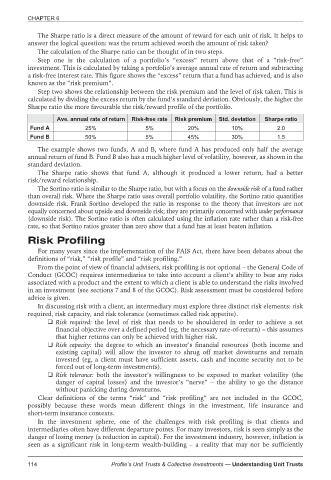Page 116 - Profile's Unit Trusts & Collective Investments - March 2025
P. 116
CHAPTER 6
The Sharpe ratio is a direct measure of the amount of reward for each unit of risk. It helps to
answer the logical question: was the return achieved worth the amount of risk taken?
The calculation of the Sharpe ratio can be thought of in two steps.
Step one is the calculation of a portfolio’s “excess” return above that of a “risk-free”
investment. This is calculated by taking a portfolio’s average annual rate of return and subtracting
a risk-free interest rate. This figure shows the “excess” return that a fund has achieved, and is also
known as the “risk premium”.
Step two shows the relationship between the risk premium and the level of risk taken. This is
calculated by dividing the excess return by the fund’s standard deviation. Obviously, the higher the
Sharpe ratio the more favourable the risk/reward profile of the portfolio.
Ave. annual rate of return Risk-free rate Risk premium Std. deviation Sharpe ratio
Fund A 25% 5% 20% 10% 2.0
Fund B 50% 5% 45% 30% 1.5
The example shows two funds, A and B, where fund A has produced only half the average
annual return of fund B. Fund B also has a much higher level of volatility, however, as shown in the
standard deviation.
The Sharpe ratio shows that fund A, although it produced a lower return, had a better
risk/reward relationship.
The Sortino ratio is similar to the Sharpe ratio, but with a focus on the downside risk of a fund rather
than overall risk. Where the Sharpe ratio uses overall portfolio volatility, the Sortino ratio quantifies
downside risk. Frank Sortino developed the ratio in response to the theory that investors are not
equally concerned about upside and downsiderisk; they areprimarily concernedwith under performance
(downside risk). The Sortino ratio is often calculated using the inflation rate rather than a risk-free
rate, so that Sortino ratios greater than zero show that a fund has at least beaten inflation.
Risk Profiling
For many years since the implementation of the FAIS Act, there have been debates about the
definitions of “risk,” “risk profile” and “risk profiling.”
From the point of view of financial advisers, risk profiling is not optional – the General Code of
Conduct (GCOC) requires intermediaries to take into account a client’s ability to bear any risks
associated with a product and the extent to which a client is able to understand the risks involved
in an investment (see sections 7 and 8 of the GCOC). Risk assessment must be considered before
advice is given.
In discussing risk with a client, an intermediary must explore three distinct risk elements: risk
required, risk capacity, and risk tolerance (sometimes called risk appetite).
Risk required: the level of risk that needs to be shouldered in order to achieve a set
financial objective over a defined period (eg, the necessary rate-of-return) – this assumes
that higher returns can only be achieved with higher risk.
Risk capacity: the degree to which an investor’s financial resources (both income and
existing capital) will allow the investor to shrug off market downturns and remain
invested (eg, a client must have sufficient assets, cash and income security not to be
forced out of long-term investments).
Risk tolerance: both the investor’s willingness to be exposed to market volatility (the
danger of capital losses) and the investor’s “nerve” – the ability to go the distance
without panicking during downturns.
Clear definitions of the terms “risk” and “risk profiling” are not included in the GCOC,
possibly because these words mean different things in the investment, life insurance and
short-term insurance contexts.
In the investment sphere, one of the challenges with risk profiling is that clients and
intermediaries often have different departure points. For many investors, risk is seen simply as the
danger of losing money (a reduction in capital). For the investment industry, however, inflation is
seen as a significant risk in long-term wealth-building – a reality that may not be sufficiently
114 Profile’s Unit Trusts & Collective Investments — Understanding Unit Trusts

